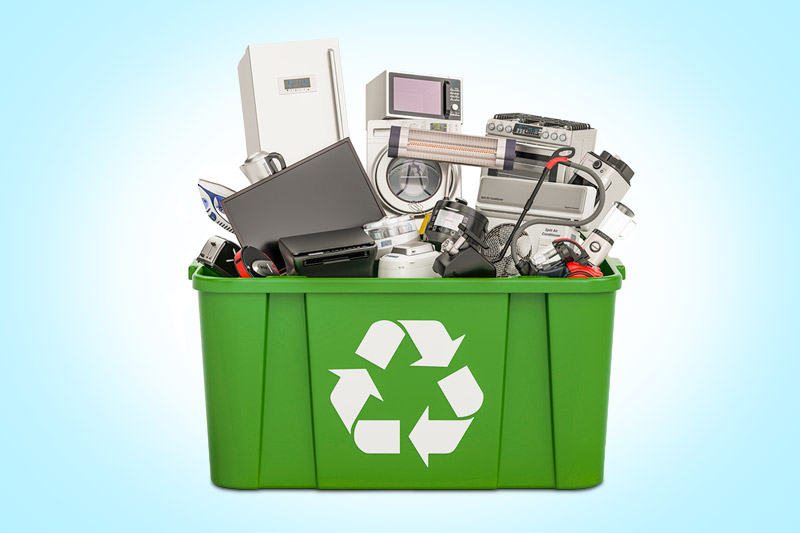Elevate Your E-Waste Management With R2 Certification: a Comprehensive Review
One secret approach to elevate e-waste administration methods is by achieving R2 qualification. By discovering the processes and advantages associated with R2 qualification, a much deeper understanding of just how it can change e-waste administration methods arises, shedding light on a path in the direction of sustainability and honest disposal techniques.
Significance of E-Waste Administration

When e-waste is not handled appropriately, these toxic materials can seep into the ecosystem, causing harm to wildlife and possibly getting in the food web, presenting risks to human health. Furthermore, the inappropriate disposal of e-waste adds to air pollution and greenhouse gas exhausts, exacerbating environment adjustment and ecological destruction.

Benefits of R2 Qualification

Firstly, R2 accreditation boosts integrity by showcasing a company's devotion to lasting practices. It ensures customers, companions, and stakeholders that the business sticks to strict standards for e-waste monitoring - r2 certification. This reputation can result in enhanced count on and boosted relationships with clients who prioritize environmental obligation
Second of all, R2 qualification helps reduce risks related to improper e-waste disposal. By complying with the rigorous standards stated by the qualification, organizations can reduce the possibility of data violations, ecological contamination, and legal effects. This proactive strategy safeguards the company's reputation and reduces possible responsibilities.
Lastly, R2 accreditation shows a dedication to environmental stewardship - r2 certification. By properly handling digital waste through licensed processes, organizations contribute to the preservation of resources, reduction of contamination, and promo of a circular economic situation. This commitment not just profits the environment yet additionally straightens with developing customer assumptions for lasting company techniques
R2 Qualification Process Introduction
Having developed the benefits of R2 certification in promoting reputation, threat reduction, and environmental stewardship, it is important to currently detail the in-depth procedure associated with getting this certification. The R2 qualification procedure starts with a complete evaluation Full Report of the company's operational plans and procedures to guarantee conformity with the R2 standard. This first evaluation is important in recognizing any type of voids that require to be dealt with prior to continuing further.
When the organization's methods align with the R2 standard requirements, an independent third-party auditor conducts an on-site audit to evaluate the implementation and effectiveness of these methods. This audit consists of an extensive testimonial of paperwork, meetings with personnel, and physical assessments of centers to confirm compliance.
Adhering to an effective audit, the company gets a certification choice based upon the auditor's searchings for. If authorized, the company is granted R2 qualification, demonstrating its commitment to liable e-waste monitoring. It is necessary to keep in mind that preserving R2 accreditation requires ongoing conformity with the requirement's requirements and routine audits to ensure continued click to find out more adherence to ideal methods in e-waste recycling and disposal.
Trick Criteria for R2 Conformity
A vital aspect of accomplishing R2 compliance is ensuring that all digital waste (e-waste) processing facilities fulfill rigid ecological and security standards. To follow R2 requirements, organizations must comply with key requirements that concentrate on liable e-waste monitoring methods. These criteria consist of applying a documented ecological, health and wellness, and security management system, guaranteeing the safe handling of data-containing devices, and carrying out thorough downstream due persistance to track the final destination of e-waste products.
Moreover, R2 compliance demands the proper testing, refurbishment, and recycling of electronic equipment to extend its helpful life and reduce environmental influence. Facilities seeking R2 qualification must additionally prioritize worker health and wellness by supplying essential training, personal safety equipment, and a secure working atmosphere. Additionally, preserving detailed records of e-waste processing tasks and frequently undergoing audits by recognized licensing bodies are crucial components of demonstrating recurring conformity with R2 requirements.
Effects of Lasting E-Waste Practices
The execution of sustainable e-waste techniques according to R2 conformity not just guarantees ecological and safety and security requirements are met yet also substantially impacts the general lifecycle of digital products. By sticking to R2 requirements, digital waste monitoring procedures end up being much more effective, decreasing the ecological footprint of digital products. Sustainable e-waste methods assist in the correct disposal of digital elements, guaranteeing that dangerous products are dealt with responsibly and do not finish here up contaminating the atmosphere.
Furthermore, sustainable e-waste practices can contribute to work creation in the recycling and repair fields, cultivating financial growth while advertising environmental duty. Generally, the adoption of sustainable e-waste practices under R2 accreditation offers as a crucial action towards achieving a more ecologically sustainable electronic devices sector.
Verdict
Finally, applying proper e-waste monitoring techniques is vital for ecological sustainability and source conservation. R2 accreditation plays an essential duty in making sure liable handling and disposal of digital waste. By adhering to the strict requirements set forth by R2 standards, companies can not only decrease their environmental influence however also contribute to a much more sustainable future for generations to come.
One trick method to elevate e-waste management methods is by acquiring R2 qualification. By exploring the procedures and benefits connected with R2 accreditation, a much deeper understanding of how it can transform e-waste management methods arises, losing light on a path in the direction of sustainability and ethical disposal methods.
The R2 qualification process begins with a comprehensive evaluation of the organization's operational policies and procedures to guarantee conformity with the R2 requirement. If accepted, the organization is provided R2 accreditation, showing its commitment to liable e-waste management. Overall, the fostering of sustainable e-waste techniques under R2 certification serves as a critical action towards accomplishing a more eco lasting electronics sector.